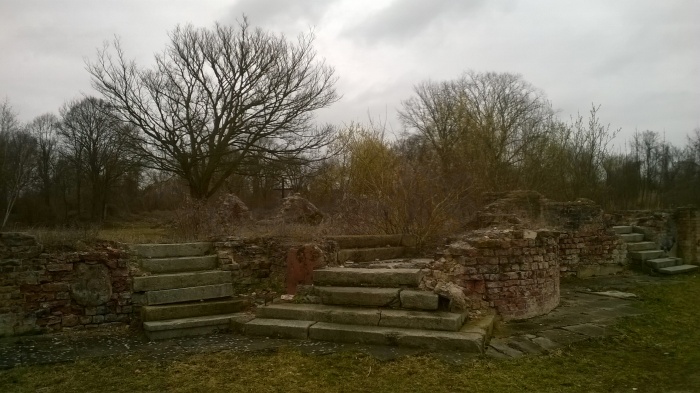Küstrin/ Kostrzyn nad Odrą is a town in western Poland at the confluence of the Oder and Warta rivers, on the border with Germany, located in Lubusz Voivodeship in Gorzów County. After the II World War the town was placed under Polish administration by the decision of the Potsdam Conference. Germans remaining in the town were subsequently expelled westward and replaced partly with Polish refugees from regions east of the Curzon line. The remnants of the old town within the fortress walls were razed after the war and the bricks used to rebuild Polish cities elsewhere. The section of the town on the west bank of the Oder remained in Germany and is now called Küstrin-Kietz.
Nowadays the Old Town of Küstrin – the historical fortress, looks like a ghost city. The life of the town stopped suddenly in 1945. It was something like the annihilation of the city of Pompeii but in other circumstances… Walking along the ramparts of the Küstrin fortress you can see the preserved paving streets and sidewalks, foundations of houses, cellars, stairs, parts of walls, pedestals statues, remnants of the castle, the town hall, the parish church, the market place. Some parts of the objects had been restored. Walkthrough the Old Town could be perceived as a time travel to the days when Küstrin was one of the most beautiful and vibrant cities in Brandenburg.

From about X to XII century most of the territory, along with its castle, was held by the dukes of Poland. Duke Mieszko I of Poland used Kostrzyn’s strategic location as a staging area during his expedition to Zehden (DE)/ Cedynia (PL) in 972. Bolesław I the Brave also prepared here for conquests and battles in Bautzen (DE)/ Budziszyn (PL) 1015-1018. The name of the town was first mentioned in 1232 in a Polish letter to the Teutonic Knights, in which the old Slavic name Cozsterine was mentioned.
In the XII century it developed into a fortified outpost and a Polish taxation post. In 1223 Prince Władysław Odonic granted the town to the German Knights Templar, but it was seized by the Margraviate of Brandenburg in 1261. By 1300 the town had received Magdeburg rights from Margrave Albrecht III of Brandenburg and started to grow rapidly, owing largely to trade on the rivers. From 1535-1571 the town was the seat of John of Brandenburg-Küstrin, who made it the capital of the Neumark region and built a castle. With time this castle was expanded into a fortress, one of the largest such facilities in the region.

While still crown prince, Frederick the Great, was imprisoned in the fortress, from which he is said to have witnessed the execution of his friend Hans Hermann von Katte on 6 November 1730. Captured by the French in 1806, Küstrin was occupied by a French military garrison for the remainder of the Napoleonic Wars. During the French retreat from the east in 1814, the town was set on fire and burnt to the ground. The town recovered and became one of the most important railway hubs in the Kingdom of Prussia and later the German Empire. In 1857 it was linked to Berlin and Frankfurt (Oder) and in 1875 with Stettin (Szczecin) on the Pomeranian coast.
In September 1923, the Black Reichswehr attempted to occupy Küstrin but it was suppressed. At the outbreak of World War II Küstrin had 24,000 inhabitants. However, due to Allied air raids on the railway hub and local factories and its position as a German bridgehead on the east bank of the Oder during the Battle of the Oder-Neisse and the Battle of the Seelow Heights, almost 95% of its buildings were destroyed (including all 32 of the city’s factories) and the town was generally deserted. The town was captured by the Red Army on 11 March 1945. The suburb Alt-Drewitz (modern Drzewice, one of Kostrzyn’s boroughs) contained a Nazi POW camp, Stalag III-C Alt-Drewitz, used mostly for American, French, Soviet, and Italian prisoners of war. From 1943-45 the town also housed a number of German forced labor camps and a sub-camp of Sachsenhausen concentration camp.
* * *
Since 2004 Kostrzyn nad Odrą hosts Woodstock Festival Poland in the summer, the largest open-air music festival in Europe and one of the largest open-air festivals in the world!

I believe my father was born in Kustrin in 1920. Do you know if there are records of birth, death, marriages from before 1920. I am researching family history.
LikeLike
Hi, yes, there must be some historical data available in the local archives. I think the best would be to contact directly the museum and the library:
http://muzeum.kostrzyn.pl/de/museum-der-festung-kuestrin/kontakt
http://www.biblioteka.kostrzyn.pl/3963,6414,nowe_dni_i_godziny_otwarcia,aktualnosci.html
biuro@muzeum.kostrzyn.pl
biblioteka@biblioteka.kostrzyn.pl
Good luck with your research!
Best regards,
Dąbrówka Stępniewska
LikeLike